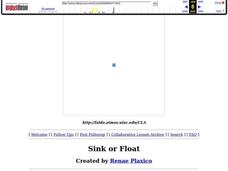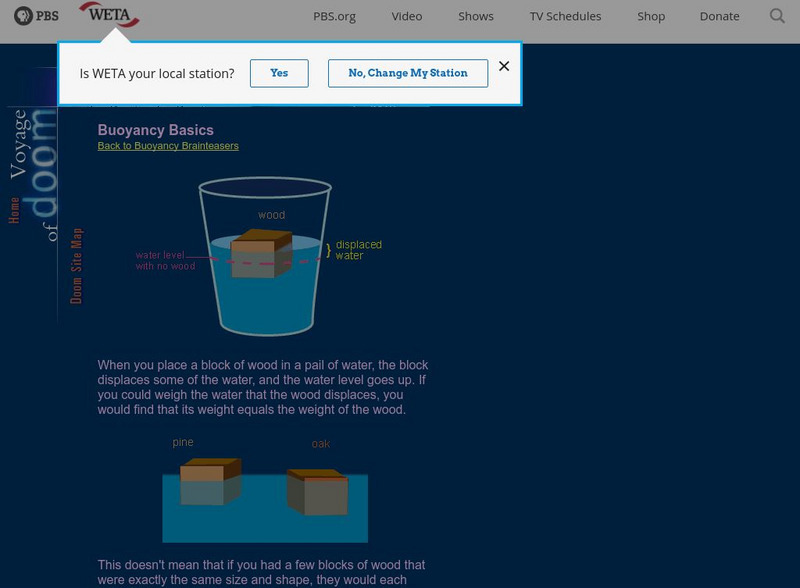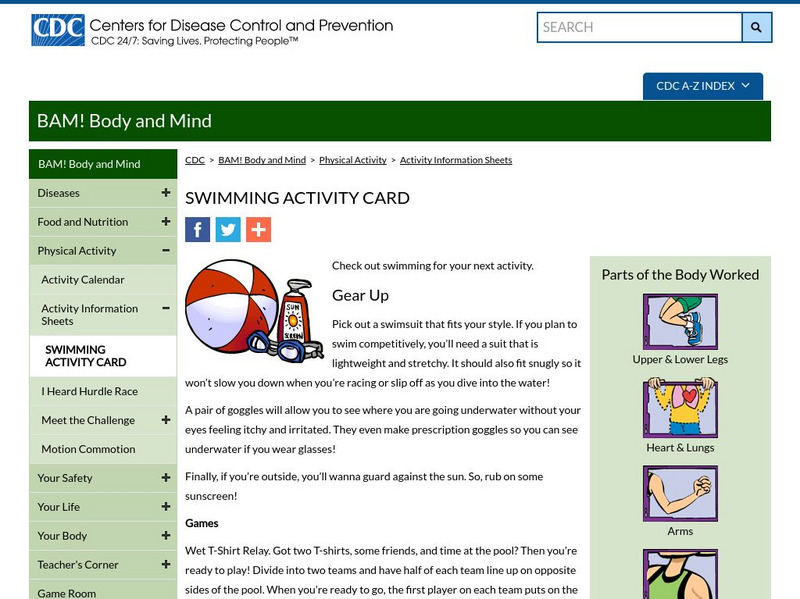Curated OER
Buoyancy
For this buoyancy worksheet, students review Archimedes principle and the difference between positive, negative, and neutral buoyancy. This worksheet has 1 fill in the blank and 7 short answer questions.
Curated OER
Floating Oranges
Students get into groups or watch one demonstration of the game. They observe an orange floating in the pool, pretending it is a little boy/girl wearing a life jacket. Next, they watch as the orange is peeled and thrown back in, with the...
Curated OER
First To Float
Students determine how to float on their backs in a swimming pool. They participate in swimming lessons at a community pool. While working in small groups they practice floating on their backs to increase their safety around the pools....
Curated OER
Weight in Water
Pupils investigate why some materials are able to float while others sink. They carry out a scientific investigation, predict and test their predictions. They record their results in a spreadsheet, and use a forcemeter in another...
Curated OER
Radical Raisins!
Students explore the concept of buoyancy through experimentation. Given materials of various weights and composition, they drop them in club soda and determine which substances sink or float. Students discuss their results in terms of...
Curated OER
Floating
First graders discuss with the teacher if everything will float in water. They observe a marble and determine whether it will float making predictions as a class. After observing the results, they discover that liquids exert an upward...
Curated OER
Activity # 13 Float or Sink?
Students have seen that solids, which are more dense than a liquid, that sinks in that liquid and solids, which are less dense than a liquid, that floats on that liquid. They use a metal boat to float in water. Pupils comprehend that...
Curated OER
Sink or Float
Students experiment with different objects to test if they sink or float. They predict what the object will do before it is put into the water. They are allowed to play with the items after the experiment is over.
Curated OER
Let's Think About Water
Students explore the different forms that water can take and conduct simple experiments to demonstrate some of its properties in each state. They watch a short video that illustrates some of these concepts.
Curated OER
Sink or Float Experiment
Students participate in an experiment to determine which objects float or sink. They use different amounts of salt for the objects and discover as the salt content increases, objects will float. They record their predictions and what...
Curated OER
Density
Ninth graders predict when an object will sink or float based on comparison of the density of the object to the density of the substance in which it is placed.
Curated OER
Sink or Float
Students construct clay boats and predict whether the boats will sink or float. Students will hypothesize what caused the boats to sink or float.
Curated OER
Can You Make A Penny Float?
Learners explore the concept of density by trying to make a penny and other materials float.
PBS
Pbs Learning Media: Buoyancy Brainteasers: Buoyancy Question
This interactive brainteaser from the NOVA: "Voyage of Doom" Web site challenges you to figure out what causes an object to sink.
University of Florida
Florida Museum of Natural History: Investigating Water
This guide engages children in the process of scientific inquiry using the context of a favorite early childhood pastime-water play.
Science Education Resource Center at Carleton College
Serc: Investigating Density in Solutions: How Can You Make an Egg Float?
In this activity, students will learn about density by determining how to make an egg float in water. By the end of the instructional activity, students will understand that density and weight are different and that density matters in...
Science Education Resource Center at Carleton College
Serc: Bowling Balls: Will They Sink or Will They Float?
Students will investigate what determines whether a material will sink or float. They will be given a bowling ball and have to make measurements and conclusions on whether their bowling ball will float, hover, or sink when placed in an...
PBS
Pbs: Buoyancy Basics
NOVA explores the basic principle of buoyancy. Also included at this site are some interesting brain-teasers related to the topic.
Other
Discontinuous Groups of Rotation & Translation in Plane
This site helps give the definition of what an n-fold rotation is. Also discusses other discontinuous groups of rotation and translation in the plane.
Other
Aquaholic: Buoyancy and Archimedes Principle
Description of buoyancy and a definition of Archimedes' Principle. Problems are presented and solved using Archimedes' Principle.
Centers for Disease Control and Prevention
Centers for Disease Control: Bam! Body and Mind: Swimming
Look here to can get expert advice on swimming. Find out what gear you'll need, safety tips, games to play, and the basics you'll have to master in order to learn how to swim.
Michigan Reach Out
University of Michigan: Paper Clip Sailing
Basic experiment that helps learners learn about surface tension.























